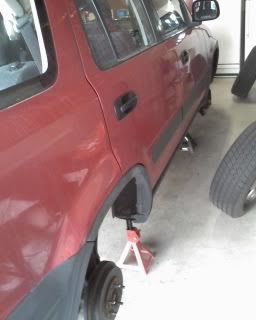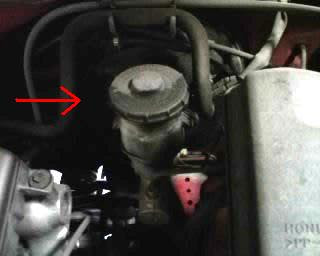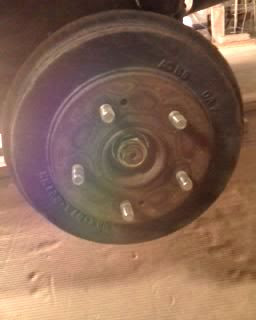That being said, if your brake pedal feels spongy, or the brake fluid in your car's brake master cylinder reservoir looks very dark, then keep reading to learn how to properly flush your brake lines. Any average person with basic mechanic/tool knowledge should be able to complete this procedure within a nice afternoon or evening. I initially decided to post these directions in order to help people save money. My sister's vehicle was scheduled to have the brakes bled at a dealership that charged around $100 for this service. That much money for a simple brake bleeding procedure seemed a little too steep, so she decided to let me do the job (for about $30.00) and now I have pictures to add to these instructions.
Supply List:
(1-2) Cans of DOT 3 Brake Fluid (32 ounce volume, DOT 3 or DOT 4 - check vehicle manufacturer's specifications)
(1) Roll of Shop Towels
(1) Can of Brake Parts Cleaner Spray (only if desired for severely soiled applications)
(1) Set(s) of Gloves (either disposable vinyl/rubber/latex gloves, or regular mechanic's gloves)
(1) Empty Container with lid (suitable for transporting used brake fluid to disposal site)
Tools List:
(1) Automotive Brake Bleeder Kit (basic kit will work, but one man bleeder kit w/vac is preferred)
(1) Automotive Floor Jack
(2) Sets of Jack Stands (4 individual jack stands total)
(1) Set of Open/Box End Wrenches (have a variety of sizes available, most applications use 3/8 " & 5/16 ")
(1) Related Fluid Funnel
(1) Lug Nut Wrench
possibly...
You may also consider using the following for safety and convenience:
(1) Sheet of Cardboard (placed under the wheel wells in case of a spill)
(1) Can of Penetrating Spray (such as PB blaster)
(1) Pair of Safety Goggles (you can never be too careful, when protecting your eyes)
(1) Set of Wheel Chocks (be safe when raising your vehicle)
(1) Chilton's/Haynes Auto Repair Manual (vehicle specific)
Like I previously mentioned, most people with basic mechanic/tool knowledge should be able to follow these directions and within a couple of hours have their brakes lines properly bled and replaced with fresh brake fluid. Now remember the goal here is to acquire the ability to bleed your own brakes, and save money at the same time. Before beginning please make sure to have all tools, parts, and products handy and ready to go; also safety comes first, work safe, be safe, and remember to use all personal protective equipment.
______________________________________________
Instruction #1



While the vehicle is still on the ground, begin by loosening all the lug nuts on each wheel; just barely loosen the lug nuts do not completely remove them. (Having the e-brake set will prevent the car from rolling while removing the lug nuts) Next locate the jack points on the underside of the car, they are usually at the front, back, and sides. Carefully jack up the vehicle and use the 4 jack stands to support it, making sure the car is level. Now finish removing the lug nuts, and completely remove each wheel. Be sure to keep the lug nuts in a safe place so they do not roll away, as well as keeping the wheels in order of where they go.
As you can see in the pictures posted above, the vehicle is levelly secured on 4 jack stands with both front disc and rear drum brakes exposed.
______________________________________________
Instruction #2


If you haven't already, you now need to pop the hood and locate the brake master cylinder reservoir. The typical location is on the driver's side, somewhat close to the firewall. If you want to check and make sure you have the correct reservoir, just look on the lid it will usually say brake fluid only and indicate what type brake fluid to use. As you can see in the above pictures, the reservoir is really dirty. We want to prevent dirt from entering the system when we remove the lid, so using a shop towel clean the lid and surrounding outside area of the reservoir. For severely dirty conditions you can use a little brake parts cleaner to cut the grime, do not allow any cleaner to enter the inside of the reservoir though.
______________________________________________
Instruction #3


Once all the dirt is removed, you then need to get the hand operated vacuum that is included in the brake bleeder kit. Remove the lid to the brake fluid reservoir, and insert the tubing so it is submersed in the current brake fluid. Having the pump connected to one end of the clear jar, and the submersed tubing connected to the other end; begin pumping until almost all the old dirty brake fluid is removed from the reservoir. Leave just enough brake fluid in the reservoir to prevent air bubbles from getting into the lines. Now set the kit aside, and get out your new bottle of DOT 3 (or other specified) brake fluid. Open it up and fill up the brake fluid reservoir all the way to the MAX line with the fresh fluid. Then as soon as possible, snugly replace the reservoir's lid.
The idea here is to remove as much dirty brake fluid as possible from the reservoir, that way you are not adding to the already contaminated fluid that needs to be bled through the lines. Okay double check that the reservoir is completely full of brake fluid and the lid is secure, and get ready for the next step.
_________________________________________________
Instruction #4
Make sure you have emptied out the dirty brake fluid from the bleeder kit's jar, into the container designated for your local household hazardous waste disposal location. Now add just a small amount of fresh brake fluid into the kit's jar so the tubing is submersed. (This is to be able to observe any air bubbles coming out, you can even use the dirty fluid but it is usually too dark to see any air bubbles) Now you are going to work your way to each wheel's bleeder valve.


Bleed the brakes in the following sequence: Left Front, Right Front, Right Rear, and Left Rear. Starting at the driver's side front brake (disc brakes in this case) locate the brake bleeder valve, and remove the rubber insulator cap, as shown above. Then get your bleeder kit, and place the end of the clear tube over the valve so a tight seal is made. Next, get the appropriate open/box end wrench, and turn the valve about a 1/4 counterclockwise so it is open and brake fluid running through the tube is visible. Now start to pump the hand vacuum (usually about 15-20 pumps) so the dirty fluid runs into the bleeder kit's clear jar. Continue to pump out all the old dirty fluid until no more air bubbles are visible, and you have a straight clean golden color of brake fluid coming out. At this time use your wrench to re-tighten the valve so it is completely closed. Remove the tube and empty out all the dirty fluid from both tube and jar into the disposal container. Replace the rubber insulator cap on the valve. Wipe up any brake fluid spills immediately, and do not let the fluid come in contact with the car's paint. Now refill the brake master cylinder fluid reservoir with brake fluid. (Whatever happens do not allow the reservoir to run dry, or you will have to restart the brake bleeding procedure) Once again pour a little bit of fresh brake fluid into the bleeder kit's jar to submerse the inside tube. Now repeat this exact same procedure on the passenger front side, and then you'll be ready for the next step on the rear brakes.
______________________________________________
Instruction #5



Now that you have completed both front brakes, you can move on to the back brakes, starting at the passenger back side. Now if your back brakes are drum equipped instead of disc, the bleeder valve should be located on the back side of the drum casing. Remove the rubber insulator cap from the valve. Drum brakes are a little more awkward, and the bleeder valve may seem harder to turn, if this is the case you can use some PB penetrating spray to help ease the stuck threads. Double check to make sure your brake master cylinder reservoir is full of brake fluid before you begin on the back. Get you bleeder kit's jar ready by adding a little bit of brake fluid so the tube is once again submersed. Now place the tube over the valve and select the correct size wrench, and turn the valve about 1/4 counterclockwise. The valve should now be open with brake fluid running through the tube, pump the hand vacuum several times until no more air bubbles are visible in the jar or stream, and the brake fluid is no longer dirty but clean. Then re-tighten the valve so it is completely closed and reinstall the rubber insulator cap back on the valve. Just as before empty out the dirty brake fluid from both the tube and bleeder kit jar into the disposal container. Refill the brake master cylinder reservoir with fresh brake fluid and get ready to finish up on the last brake. Finally finish the actual bleeding process by ending with the driver side rear brake, by repeating the previous procedure.
When bleeding each brake it should look something like the image below.
Instruction #6
Now that the actual brake bleeding process is done it is time to put everything back together. However, before you do, it is an excellent time to double check on everything and inspect the other aspects of your brakes. Begin by topping of the brake master cylinder reservoir with brake fluid all the way to the MAX line, then be sure the lid is on tight. Go around to each wheel and make sure all the bleeder valves are completely closed (this is vital for braking performance) Once you have double checked all that you have worked with in this process, you might as well inspect your brake pads while the wheels are removed. Make certain that there is an adequate amount of brake pad material left, and that the drums and rotors are in good shape. And if possible it is a good idea to check the brake lines them selves for any problems/leaks.
Now reinstall all four wheels/tires, lower your vehicle and completely tighten all of the lug nuts. You can now clean everything up, and take your car for a little test drive to make sure your brakes work well. Before you go driving though make sure you have significant brake pedal pressure, and just take it slow and easy at first.
Lastly remember to take your used brake fluid to your local household hazardous waste disposal location.
Be Safe and Use Common Sense while bleeding your car's brakes. I cannot/will not be held liable for any damages, injuries, or other losses
